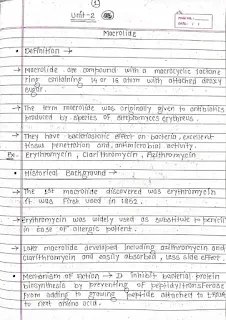Medicinal Chemistry-3 Unit-1 Notes-1 - Free Download
Download the first part of comprehensive Medicinal Chemistry-3 Unit-1 Notes. This resource provides detailed insights into crucial topics for students pursuing pharmaceutical sciences, covering foundational concepts and specific drug classes. Available for free download or online viewing on Sildes By DuloMix.
Keywords: Medicinal Chemistry 3 PDF, Unit 1 Notes, Pharma Chemistry, Drug Action, Medicinal Chemistry Syllabus, B.Pharm Notes, M.Pharm Notes, DuloMix, Sildes By DuloMix, free notes
Medicinal Chemistry-3 Unit-1: Foundations of Drug Design and Action (Part 1)
Medicinal Chemistry is the discipline at the intersection of chemistry, especially synthetic organic chemistry, and biology, involving the design, chemical synthesis, and development for market of pharmaceutical agents (drugs). Medicinal Chemistry-3 often delves into advanced topics and specific therapeutic areas, building upon foundational knowledge. Unit-1 typically lays the groundwork for understanding the principles of drug action and design in complex biological systems.
Introduction to Drug Discovery and Development
The journey of a drug from concept to market is a long and arduous one, often taking over a decade and costing billions of dollars. Medicinal chemistry plays a pivotal role in this process. Unit-1 of Medicinal Chemistry-3 usually begins by revisiting the overall drug discovery and development pipeline, emphasizing the key stages where medicinal chemists contribute:
- Target Identification and Validation: Identifying specific biomolecules (e.g., proteins, enzymes, receptors) implicated in a disease pathway that can be modulated by a drug.
- Lead Identification: Discovering initial compounds (leads) that show promising activity against the validated target. This can involve high-throughput screening of compound libraries, natural product isolation, or rational drug design.
- Lead Optimization: Modifying the chemical structure of the lead compound to improve its potency, selectivity, pharmacokinetic properties (ADME – Absorption, Distribution, Metabolism, Excription), and safety profile. This is where the core of medicinal chemistry principles are applied.
- Preclinical Development: Extensive in vitro and in vivo testing to assess toxicity, efficacy, and pharmacokinetics in animal models.
- Clinical Trials: Human trials conducted in three phases to evaluate safety, efficacy, and optimal dosage.
Principles of Drug Action and Receptor Theory
A fundamental concept in medicinal chemistry is how drugs interact with biological targets to produce their effects. Unit-1 often deep dives into:
- Receptor Theory: Discussing how drugs bind to specific receptors (e.g., GPCRs, ion channels, enzyme-linked receptors, intracellular receptors) to initiate a biological response. This includes concepts like affinity, efficacy, and intrinsic activity.
- Agonists and Antagonists: Differentiating between agonists (molecules that bind to a receptor and activate it), partial agonists, and antagonists (molecules that bind but do not activate, thereby blocking the action of agonists).
- Drug-Receptor Interactions: Examining the types of chemical bonds (ionic, hydrogen, Van der Waals, hydrophobic, covalent) involved in drug-receptor binding and how these interactions dictate specificity and potency.
Structure-Activity Relationships (SAR)
SAR is a cornerstone of medicinal chemistry. It involves understanding how changes in the chemical structure of a compound affect its biological activity. In Unit-1, students learn to systematically modify a lead compound and observe the impact on its efficacy, potency, selectivity, and pharmacokinetic profile. Key aspects include:
- Identification of Pharmacophore: Defining the essential structural features required for biological activity.
- Isosterism and Bioisosterism: Replacing atoms or groups with others that have similar electronic or steric properties to improve activity, reduce toxicity, or alter ADME properties without losing activity.
- Functional Group Modification: How modifying specific functional groups (e.g., introducing a halogen, changing alkyl chain length, or varying ring substituents) can fine-tune drug properties.
Introduction to Drug Metabolism
Understanding how the body metabolizes drugs is critical for designing compounds with desired duration of action and reduced toxicity. Unit-1 provides an overview of drug metabolism, typically covering:
- Phase I Reactions: Functionalization reactions such as oxidation, reduction, and hydrolysis, primarily catalyzed by cytochrome P450 enzymes. These reactions often introduce or expose polar functional groups.
- Phase II Reactions: Conjugation reactions where the drug or its Phase I metabolite is coupled with an endogenous polar molecule (e.g., glucuronic acid, sulfate, glutathione), making it more water-soluble for excretion.
- Impact on Drug Design: How medicinal chemists design drugs to resist undesirable metabolism or to produce active metabolites.
These initial topics in Medicinal Chemistry-3 Unit-1 provide students with the conceptual tools and knowledge base essential for tackling more complex drug classes and design challenges in subsequent units. It emphasizes the iterative and multidisciplinary nature of drug discovery, bridging fundamental chemical principles with biological outcomes.
Info!
If you are the copyright owner of this document and want to report it, please visit the copyright infringement notice page to submit a report.

